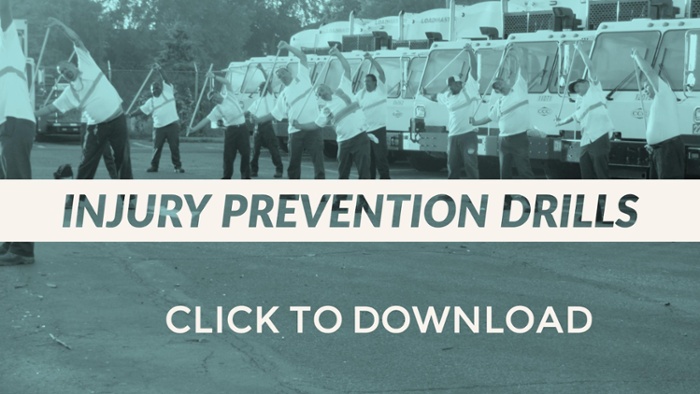Regardless of the job environment, many employees are generally standing or sitting much of the day and performing important, yet repetitive, tasks (standing, sitting, lifting, twisting, etc.).
If we aren't intentional about countering these daily repetitive tasks we'll see more mobility and stability problems over time and increased risk for musculoskeletal injuries (strains, sprains, pain, etc.) that impact both work performance and quality of life.
Injury Prevention Program
We designed a program to support the movement competency needs of these groups that can have a big impact in a short period of time.
These stability and mobility (STAMO) drills are more than just stretching and are central to neuromuscular retraining (typically applied in a therapeutic enviornment) - meaning they are a reminder to improve functional ability on everyday tasks like squatting, bending, rotating, reaching, pulling and remaining balanced during those movements. These are all movements that most people do every day and should be able to do well throughout their life.
The reason most bodies need daily neuromuscular reminding is because much of the work done in manufacturing or office work is repetitive. Repetitive sitting or standing both can have a negative impact on the body. Repetitive sitting can the neuromuscular reactiveness around the hip and back in particular. This can be felt after sitting for a long time and then standing up. You might feel really tight through the hips and low back area which can initially be managed by stretching but over days and months of the sitting repetition we often start to see more lasting compensations in the vertebral and hip region. The same could be said for repetitive standing.
People, trying to find ease in long duration standing positions often come to a compensated standing pose (ie. feet turned out, knees hyperextended, hip tilted either forward or backward). In the short term, not a big deal. In the long term, compensated movement patterns can lead to injury and pain (ie. knee damage due to compensated wear patterns or back problems due to compensated lower extremity posture).
The same could also be said for upper extremity repetitive motions like keyboarding, machine manipulation, or repetitive physical tasks. Relative to repetitive physical tasks, much like a skilled athlete who completes many repetitions of a skill to learn it well and then performs it repetitively at a high level, compensations will be developed on the way to those enhanced skills.
For example, a right handed baseball pitcher, will develop a stronger left leg and hip since it is the braking leg, very strong trunk rotation to the left, upper back and arm muscles on the right side will be stronger and due to that strength may pull the vertebral column out of alignment and to the right side.
The problem for the athlete or the manufacturing worker is that the compensations for performance come with a cost to other movement functions. If we do not actively counter the impact of the worker or athlete training, we develop an unbalanced and compensated worker who WILL suffer movement limitations or injury due to the compensations.
The daily STAMO program we developed has several benefits:
-
The movements performed well will remind/reteach appropriate movement patterning.
With good explanation and delivery, people, once reminded, will tend to practice these better movement practices across the day. Further they will be more likely to notice when they are “out of balance” and have skills to correct it.
-
The movements are linked to normal activities that people do daily
Movements like squatting, lunging or stepping, reaching, pulling, and rotating are movements we would all hope to be able to do throughout our lives. They are also linked to more fully lived and independent lives. When we can not do these movements without pain or failure, movement compensations become more severe or people quit trying to do the movement. On the job this could be dangerous. In life, not moving or avoiding movement, may lead to increased risk for chronic diseases like heart and vascular disease, diabetes, and overweightness.
-
The movements are slow and involve breath control and balance.
-
The movements have a movement and cognitive function
The movements are designed so people will learn what good posture feels like in all the movement patterns. When performed well, participants will understand the why behind the pattern and increase their awareness about when they are compensating. In addition, there is an emotional component (using the breath to get centered and for stress reduction) that is built into each exercise.
-
We use the stick because it is a form reminder.
-
The mobility and stability movements need to be done regularly.
Creating a daily practice is important to counter the short term effects of whatever compensations we did during the day. In our experinece, a train-the-trainer model that supports people completing this practice together at their worksite is highly impactful.


